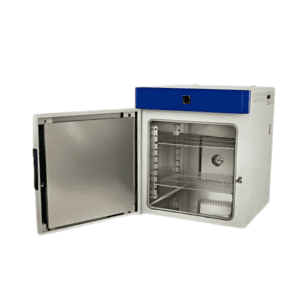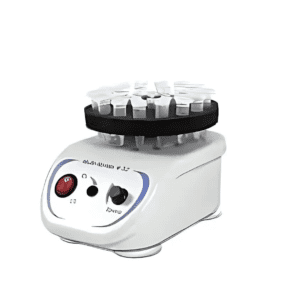Description
Laboratory shakers are pivotal in numerous scientific applications, facilitating the blending, agitation, and processing of samples to achieve consistent and reliable results. They are widely utilized in fields like chemistry, biology, and biochemistry for tasks such as cell culture growth, reagent mixing, and sample preparation.
Types of Laboratory Shakers:
- Orbital Shakers: These shakers provide a circular, orbital motion, ideal for applications requiring gentle to moderate mixing, such as culturing microorganisms and washing blots. They are commonly used for general mixing tasks.
- Linear Shakers: Operating with a back-and-forth motion, linear shakers are suitable for applications requiring thorough mixing, such as suspending cells or resuspending pellets.
- Vortex Mixers: Designed for mixing small volumes in tubes or vials, vortex mixers rapidly agitate samples, making them suitable for applications like resuspending cell pellets or mixing reagents.
- Incubated Shakers: Combining shaking and temperature control, incubated shakers maintain optimal conditions for cell growth, enzyme reactions, or other temperature-sensitive processes.
- Rocking Shakers: Providing a gentle, see-saw motion, rocking shakers are ideal for applications requiring minimal agitation, such as hybridization procedures or blotting techniques.
Key Features to Consider:
Speed Range: Depending on the application, select a shaker that offers the appropriate speed settings, ranging from gentle agitation to vigorous mixing.
- Platform Size and Capacity: Choose a shaker with a platform size and weight capacity suitable for the number and size of vessels you intend to use.
- Motion Type: Consider the required motion (orbital, linear, vortex, etc.) based on the specific mixing needs of your applications.
- Environmental Compatibility: Some shakers are designed to operate within incubators or cold rooms, maintaining performance under varying environmental conditions.
Applications:
- Cell Culture: Providing consistent agitation to maintain cell viability and promote growth.
- Sample Preparation: Ensuring uniform mixing of reagents, buffers, or samples before analysis.-
- Hybridization and Blotting: Facilitating gentle mixing during nucleic acid hybridization or protein blotting procedures.
Maintenance and Safety:
- Regular Calibration: Ensure the shaker’s speed and motion are accurate to maintain consistent results.
- Cleaning: Keep the shaker and its components clean to prevent cross-contamination and ensure longevity.
- Load Balancing: Always balance the shaker’s platform by evenly distributing samples to prevent mechanical stress and potential damage.
- Operational Training: Ensure all users are trained in the proper operation and safety protocols associated with the shaker to prevent accidents and ensure effective use.
By selecting a laboratory shaker that aligns with your specific application requirements and adhering to proper maintenance practices, you can enhance the efficiency and reliability of your laboratory processes.





